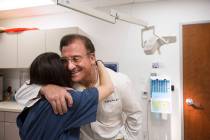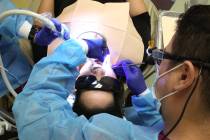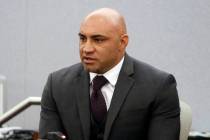We need a clearer picture of Lasik
Every time I hear sports talk show host Paul Howard selling Lasik eye surgery – it only took him a few painless minutes to acquire 20-15 vision – I think of a woman I wrote about in Texas who lost her sight from a laser procedure.
Her emotional appeal to me to let people know that such surgery is not without risk has stayed with me. I cringe at how cavalierly surgical procedures of all kinds can be marketed.
I’m a sports addict, so I enjoy ESPN Radio 1100-AM and 98.9-FM. It’s difficult to miss on-air talent pitching Dr. Richard Rothman’s Lasik of Nevada. To hear them tell it, virtually nothing is easier than a procedure that changes the shape of the cornea in hopes of producing better vision.
Yet the Food and Drug Administration counsels that it can cause vision loss and debilitating visual symptoms.
It also cautions: “The long-term safety and effectiveness of Lasik surgery is not known.”
No warnings accompany the testimonial ads run for Rothman.
But a 2011 FDA letter to physicians reads: “It is critical to disclose risk information appropriately and effectively to consumers in all advertisements and promotional material including the consequences that may result.”
Rothman said Thursday he warns patients about risks in his office.
In an email Thursday, an FDA spokeswoman wrote: “The FDA is prepared to take regulatory action against eye care professionals for improper advertisements and promotions if the issues referenced in the most recent letter are not resolved.”
Rothman, like many U.S. eye surgeons, markets through celebrities. For instance, he gave Howard his procedures, which run around $4,000, at no cost in return for “from the heart” testimonial ads.
That radio listeners don’t know this doesn’t give either man ethical concerns.
“I truly believe he’s the best,” said Howard, who admits hearing “horror stories” about people who didn’t go to Rothman for the procedure.” I don’t think there’s a risk in the surgery if you go to him.”
Rothman, who must wear glasses to see well, does.
“Mechanical devices can have problems,” Rothman said of lasers. “And surgeons are human.”
Rothman, who said he’s not a good eye surgery candidate because his corneas are “too thin,” said he doesn’t know what percentage of his patients end up with serious vision problems, but did say “very few” do.
Morris Waxler, the retired branch chief at the FDA who oversaw approval of devices used for Lasik surgery in this country, said serious problems arise in 20 percent of Lasik surgeries in the U.S., though they often don’t show up for a few years.
Solid studies are hard to come by because it’s an elective procedure with no insurance involved, but a study done by eye doctors put the patient satisfaction rate at 95 percent.
Waxler said that since leaving the agency he reviewed data and learned safety information was withheld by the “Lasik establishment.” Last year he filed a petition with the FDA, which is still under review, asking that Lasik be halted. Last month he posted a letter on the Internet asking “Lasik injured patients” to sign the petition.
Since the 1990s, he wrote, “Many thousands of eyes have been damaged beyond repair. Approximately 700,000 eyes will receive refractive surgery with Lasik devices by the end of year 2011. Thus, more than 4,630 are projected to face blindness.”
I know most people, including my brother, have had success with Lasik.
But a truthful ad might go like this: “Most will see better with Lasik, and some won’t see it all. Isn’t that a gamble worth taking?”
Paul Harasim is the medical reporter for the Las Vegas Review-Journal. His column appears Mondays. Harasim can be reached at pharasim@reviewjournal.com or 702-387-2908.












